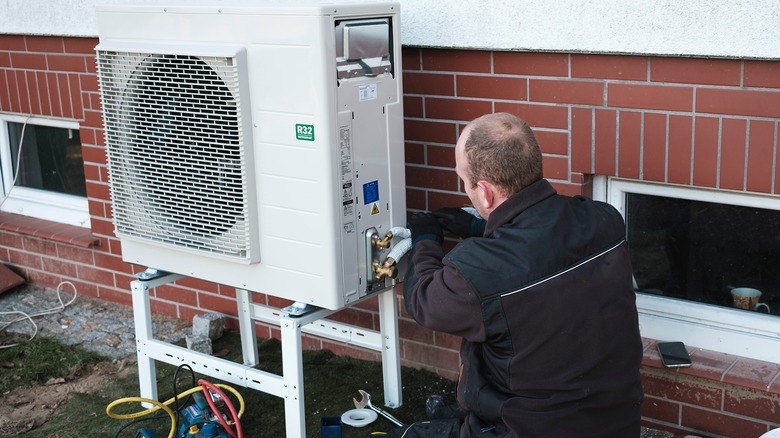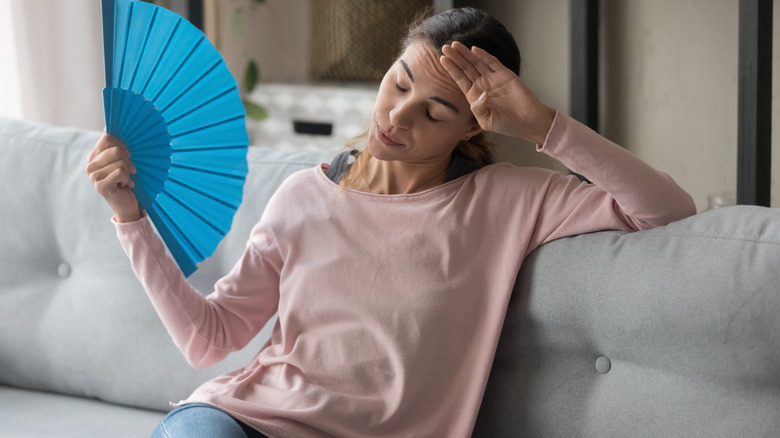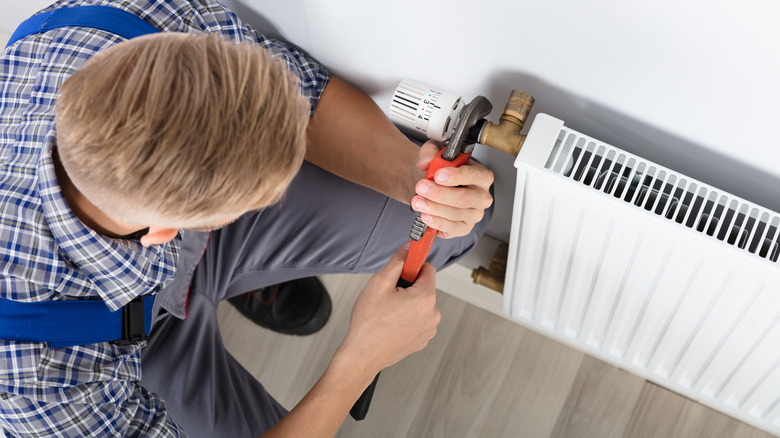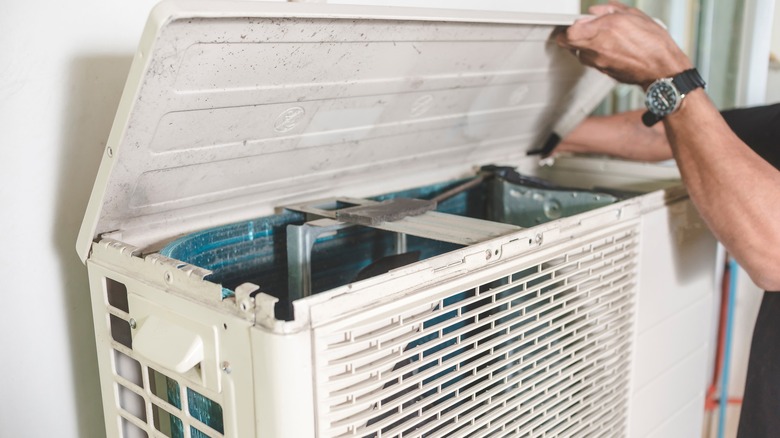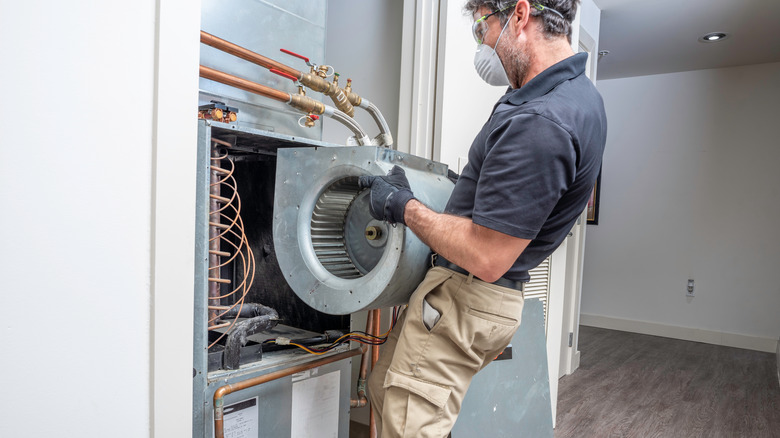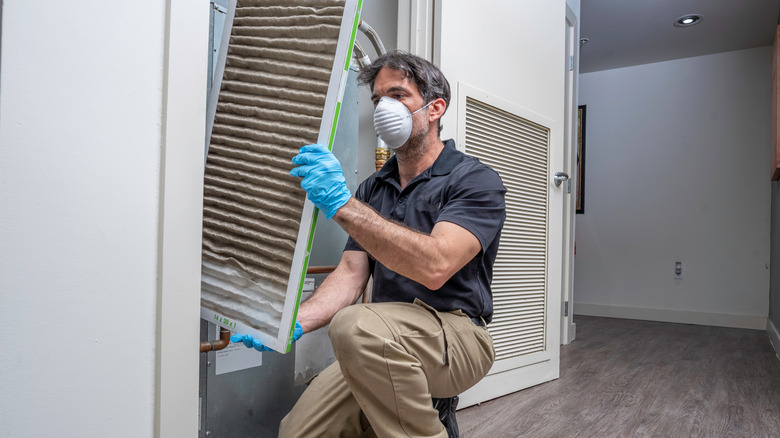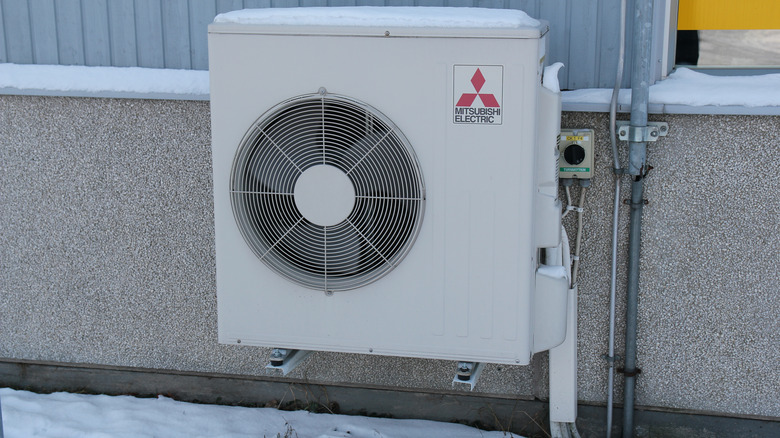How To DIY A Heat Pump Repair
Appliance malfunctions are super annoying, especially when they affect the comfort of your living space. A broken heat pump on a cold day can be enough to have you seeking new shelter. But just like every object, your heat pump is subject to wear and tear, so it's common to stumble upon an issue or two. With this in mind, having knowledge of some heat pump repair basics can save you a lot of time and effort instead of having to call a professional for every minor issue.
Before we get into how to repair common heat pump problems, it is important to note how they work. According to Action Air, a heat pump uses a compressor to circulate refrigerant that absorbs and releases heat between the indoor and outdoor units. So simply, when it is freezing outside, the heat pump warms your home by transferring heat inside your home. And when it's scorching hot, it moves the hot air from inside your home out. Heat pumps transfer heat rather than generate it, making them more energy- and cost-efficient than other heating systems (via Cielo).
Heat pump is running constantly
It is normal for your heat pump to run constantly in extreme weather since it relies on outdoor air to provide heating energy. But when the temperature is mild and your unit is still running constantly, what should you do? The first advice Cielo gives is to check your thermostat settings. If they are set to high or too low, your heat pump will have to work constantly to maintain that temperature. The ideal maximum thermostat setting is 78 degrees Fahrenheit for summer and between 68 and 72 degrees Fahrenheit for winter.
Another possible cause is dirty air filters and coils, according to Carrier. A heat pump's job is to supply clean and fresh air. When the filters are clogged, it restricts the flow of air, and your pump has to work harder to maintain the set temperature. The same goes for dirty coils. According to Home Tips, heat passes through the pump coils, so if they are dirty or frozen, less heat will be conducted. Try cleaning both the coils and filters. If the problem persists, there may be a deeper issue that requires professional attention.
Heat pump isn't running
If your heat pump won't run at all, there could be a few possible problems. One is thermostat malfunctions. First, check that all of your thermostat settings are correct, according to Leonard Splaine Co. If all settings appear correct, it may be a bad wiring job or miscalibration that is causing your thermostat to read the temperature incorrectly. Either way, seek the attention of a professional to check wiring and heat conductors.
Another problem may be the power switch, per Minnick. Although most heat pumps don't come with power switches, check if yours do and make sure they are on. Your heat pump may also not be running because of a tripped breaker or blown fuse. Heat pumps have auxiliary heating elements, and the conductors may overheat, damaging the electrical components within (via Home Tips). Check both the main electric panel and any other subpanels to reset the breaker. Simply flip the circuit breaker off and then on. If your circuit trips again, call the attention of a professional to look into the problem.
Heat pump makes noise
Most heat pumps aren't going to be silent. They are typically made of metal, which is a noise conductor. If the noise is bothering you, you can reduce it by placing flexible insulation ductwork between the heat pump and ductwork runs (via Home Tips). While some level of noise is normal, if you hear rattling, squeaking, or popping, there may be an issue with your pumps.
If you hear rattling noises, check if any loose parts need to be tightened. Check the cover panels and tighten them. If the rattling noise continues, seek the attention of a professional; there might be a problem with the ductwork or loosened parts in the air handler (via Minnick).
If you hear a popping sound, it might be caused by thermal expansion of the ductwork or air blowing a loose flap of metal. To solve this, listen to identify the source of the sound. When you find it, make a small dent in the sheet metal to create a stiffer surface that is more likely to stay in place while the unit is running, per Home Tips. If any abnormal noises persist, it's best to call a specialist.
Heat pump does not heat or cool properly
The hot air discharged from heat pumps typically won't be as hot as that from an oil or gas furnace. But if the air blowing is cold or not sufficiently heated, you can try these possible repair solutions.
First, Carrier advises that you check your thermostat to ensure it is set properly. Raise the temperature by 5 degrees Fahrenheit and wait a few minutes for the heat to come on. After, ensure the vent cover is open to allow air circulation.
In this case, the cause could once again be dirty filters, coils, or fans. Clean them up and see if that solves the problem, per Leonard Splaine Co. You should also check to see if the air duct or air handler is blocked, per Minnick. If this doesn't help, check the pump's auxiliary heating elements. If the problem persists, it may be an internal problem, and you should seek help from a professional.
Heat pump turns off after you turn it on
According to Cielo, when your heat pump constantly turns off right after you activate it, the problem is that your unit is short cycling. Various situations can cause short cycling. One cause of short cycling is overheating. When a unit's air filters are dirty or clogged, it may overwork to maintain the set temperature. In response to this, your heat pump may shut down.
If, after cleaning your air filters, the problem continues, Home Tips advises checking the thermostat. This is most likely the source of the problem. When a thermostat is improperly calibrated or installed in a place where it can't get an accurate reading of the air in the room, it will begin short cycling. For example, if your unit is placed where the sun hits directly, it may detect higher temperatures and turn off before reaching the set temperature.
Heat pump freezes up or trips breaker
It is common for heat pumps to freeze up during the cold winter months. There is typically a defrost cycle that should make any ice melt away, but if the ice reaches the condenser unit of the heat pump, the defrost cycle may seize. To fix this, Minnick advises switching it off so the condenser can defrost. Also, you should ensure the air filters are clean and the return-air registers are unclogged.
When the power to the heat pump goes out, it's important to note that most units have auxiliary heating elements that provide heat during extremely cold weather (around 20 degrees Fahrenheit) and when the heat pump efficiency is too low. According to Home Tips, they tend to draw too much power and trip the breaker when they come on. Whenever this happens, you should locate the circuit breaker and reset it.
